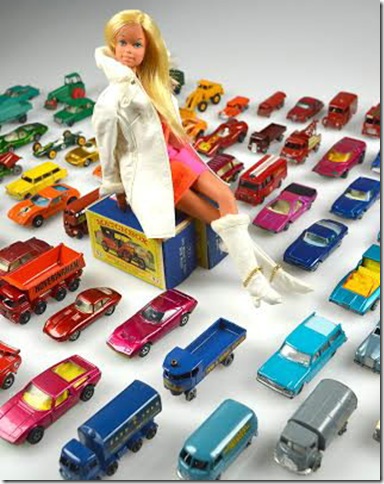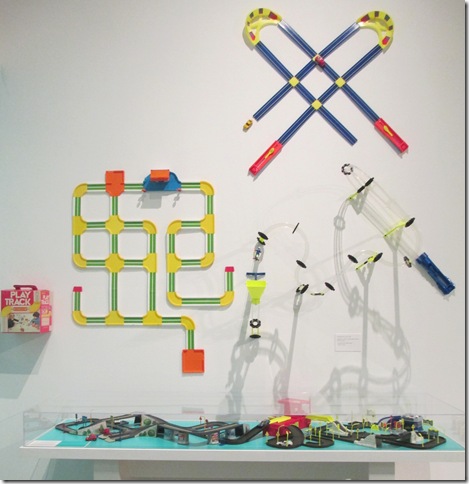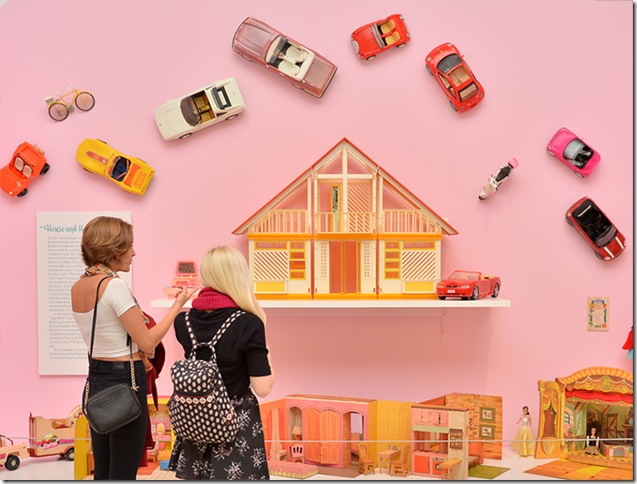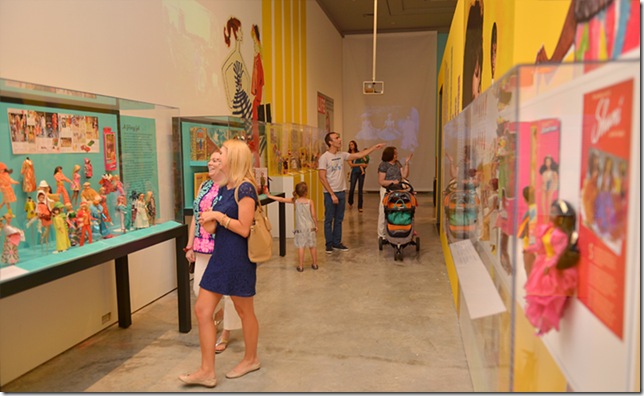If there was a heaven for toys, it probably would look and feel like the Norton Museum of Art’s new exhibition. This is what a toy gets for enduring decades and co-existing with digital era’s sharp apps: a show of its own at a major local museum.
If such heaven existed, then Matchbox cars, Hot Wheels cars and Barbie dolls arrived at it last week, with the opening of Wheels & Heels: The Big Noise Around Little Toys. Those attending the kickoff celebration could not wait to fake having rigid arms to have their photo taken inside the life-size Barbie box in the first gallery room. They could not have known the first Barbie with moveable hands emerged in 1970.
Wheels & Heels has all the components (black-and-white photographs, vintage ads and old footage) of a serious exhibition but is definitely designed to entertain a summer audience. Bright walls frame the setting and quickly warm up visitors to the point of sharing personal anecdotes with complete strangers. Everyone has a toy story to tell and that is the point of the show, to explore the impact of these objects as well as their history and origin.
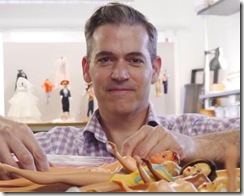 One gets to see Barbie’s horse, college dorm, cars, dogs and several of her pretty pink houses. In the first 30 years of the doll’s life, manufacturer Mattel Toys produced more than 6,000 outfits for her. Even Oscar de la Renta designed outfits for Barbie. Some are displayed here along with the Givenchy and Anne Klein editions. De la Renta was one of many fashion designers who collaborated with Mattel. Today, collectors are willing to pay $200 for a doll with the right characteristics, but in 1959 she was only $3.
One gets to see Barbie’s horse, college dorm, cars, dogs and several of her pretty pink houses. In the first 30 years of the doll’s life, manufacturer Mattel Toys produced more than 6,000 outfits for her. Even Oscar de la Renta designed outfits for Barbie. Some are displayed here along with the Givenchy and Anne Klein editions. De la Renta was one of many fashion designers who collaborated with Mattel. Today, collectors are willing to pay $200 for a doll with the right characteristics, but in 1959 she was only $3.
The abundant amount of miniature cars and doll editions spreading across several rooms was assembled by guest curator Matthew Bird, an associate professor of industrial design at the Rhode Island School of Design. Vintage racetracks and Barbie accessories complement the collection. There is also a dark room with three screens replaying television commercials. Further ahead, a catwalk invites visitors to model designs while looking at a runway model on TV. WARNING: The catwalk is very hard to resist.
It is a good thing the show does not hide the harmful social impact the toys had. Bird himself has said they were radical for the time. For instance, the 1965 Slumber Party outfit came with a scale set at 110 pounds and among the early professions suggested for and by Barbie were flight attendant, nurse and teacher. But the upsetting notions some dolls accidentally or intentionally promoted do not eclipse the encouragement spread with others. Here, one meets the pilot, NASCAR and astronaut dolls as well as competitive ones. The Olympic skater doll spins at the waist while the gymnast edition specializes in splits.
It comes as a shock that the black Barbie did not arrive until the 1980s, but compared to other toy makers, Mattel’s take on race happened early. And once it did, the company made sure to hire a psychologist with expertise on play therapy and diversity to help at the creative stage. The Dolls of the World illustrate the company’s sensitivity and awareness of other cultures. It features a striking line up of exotic dolls representing different parts of the world through their native outfits and headpieces.
Not surprisingly, targeting children through catalogs and promotions was a common practice. Lesney Products, the British company behind Matchbox, turned little ones into avid collectors and consumers. The company put out a limited line of 75 car models and kept changing it so that a full collection was never achieved. By the time a collector acquired all 75 models, many were modified or replaced. There are up to 15 varieties of each vehicle. The initial set of Matchbox models sold for less than 18 cents. By 1969, more than 600 million miniature cars had been sold and more than five million were being produced per week. Mattel created the flashier Hot Wheels cars in 1968 and bought the Matchbox brand in 1997.
There surely was a time we all wanted to be blonde and sport shiny long hair or have the flashiest, fastest car with fancy wheels. Seeing how different or alike one has become in relation to one’s toys is part of the fun of the show.
The less-fun part has to do with the writing literally on the wall. One can hear this side of the room grow quiet as visitors read the big white letters suggesting today’s children might not have an exhibit like this one when they grow old. The message highlights what we already know. There is a lack of physical interaction and little interest in physical toys. Then again, the Wheels & Heels of tomorrow could resemble the video game exhibition at the Boca Museum of Art last year. Galleries could be dedicated for displaying old and new game systems.
For any toy, getting the art treatment would feel like paradise, but unlike dogs, not all toys deserve to enter heaven.
Wheels and Heels: The Big Noise Around Little Toys runs through Oct. 26 at the Norton Museum of Art, 1451 S. Olive Ave, West Palm Beach. The museum is open Tuesday, Wednesday, Friday and Saturday from 10 a.m. to 5 p.m.; Thursday, 10 a.m. to 9 p.m.; and Sunday from 11 a.m. to 5 p.m. (Closed on Mondays and major holidays). General admission is $12 for adults, $5 for students with a valid ID, and free for members and children ages 12 and under.
